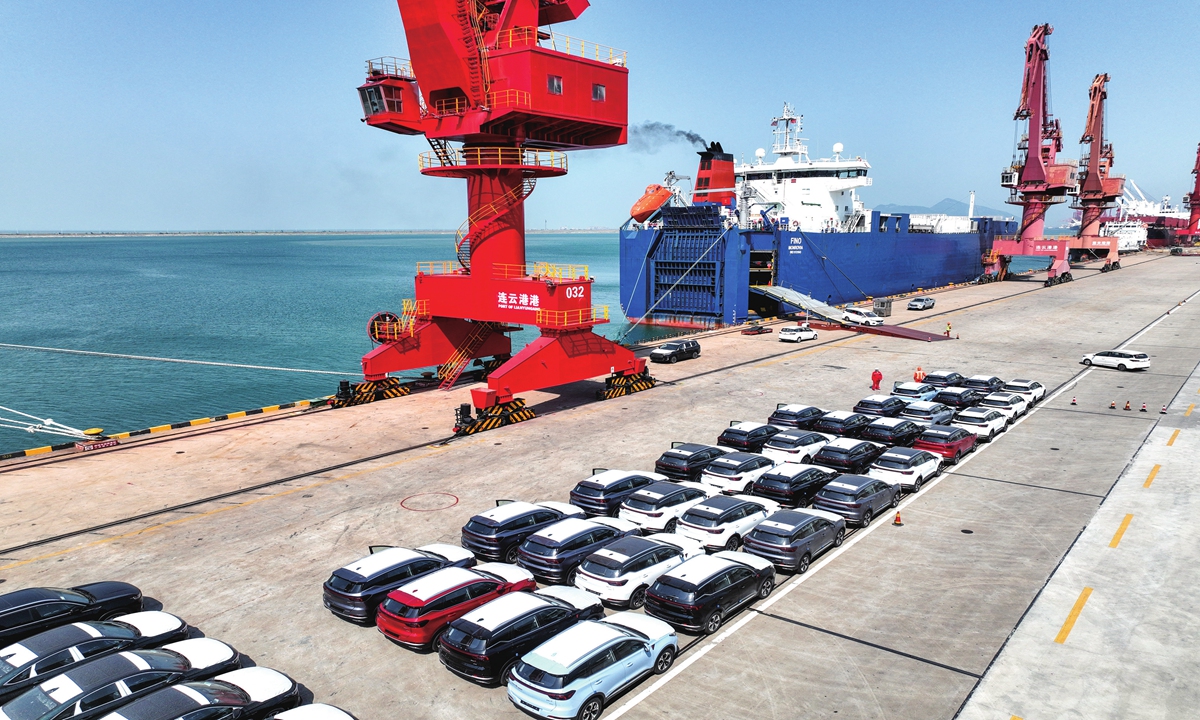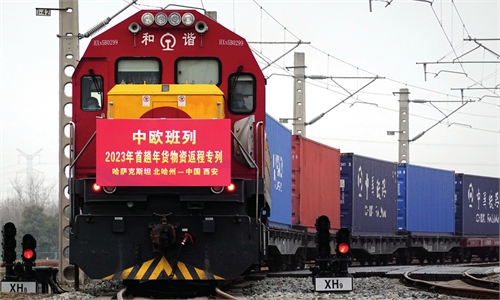
A ro-ro vessel parks at a berth loading trucks for export at a terminal in Lianyungang port in Lianyungang, East China's Jiangsu Province on May 15, 2023. China's auto exports rose 89.2 percent year-on-year in the first four months of 2023. Photo: VCG
China's exports to the US, its third largest trading partner, continued to decline in May amid Washington's "decoupling from China" push that are hurting normal bilateral ties.Bilateral trade came in at 390.46 billion yuan ($54.84 billion) in the first five months of the year, down 5.5 percent year-on-year.
China's shipments to the US dropped 8.5 percent in the first five months, while imports from the US were up 3.9 percent, data released by China's General Administration of Customs (GAC) showed on Wednesday.
The trade surplus with the US has narrowed by 14.5 percent in the January-May period, standing at 870.57 billion yuan.
In May, China's shipments to the US stood at 292 billion yuan, down 12.2 percent on a yearly basis, marking the 10th straight month of decline. On a month-on-month term, the shipments registered a slight drop of about one percent from April.
The continuous decline of Chinese exports to the US largely reflected the latter's economic problems as American consumers are struggling with elevated inflation which has restricted import demand, Li Yong, deputy chair of the expert committee of the China Association of International Trade, told the Global Times on Wednesday.
The US Federal Reserve insisted on policy tightening in order to tame inflation by raising its key interest rate last month by a quarter-point to the highest level in 16 years.
In addition, the US' tariffs on some Chinese goods which were slapped under the previous Trump administration are causing self-inflicted harm on US consumers, Li said.
The Section 301 tariffs on imports from China harmed American businesses, workers, and the US economy, costing the poorest the most, according to a research analysis by the Cato Institute, an American think tank headquartered in Washington, D.C.
Even though the USTR has moved through the review process, Li thought that there is little possibility for the Biden government to eliminate the tariffs in the near future, "because they need it as a vehicle to achieve its political purpose."
China's export drop to the US has another cause that more US imports have shifted to Western Europe and North America, which may reflect the strong resilience of US demand for high-value durable consumer goods in the post-epidemic period, according to an analysis report by Golden Credit Rating International.
Wang Qing, chief macroeconomic analyst at the agency, noted that China's exports to the US are unlikely to see a positive growth in the short term.
In contrast to the US' decoupling attempt, China has been unswervingly pushing for opening-up and sharing its growth dividends with the world, and the country is set to become both a stabilizer and a locomotive for global development.
It has embraced diversified foreign trade markets around the world, with growing trade momentum with ASEAN, and countries along the Belt and Road Initiative (BRI).
In the first five months, the structure of China's foreign trade continued to improve, with the country's trade with its major trade partners posting noteworthy growth.
The ASEAN remains China's largest trade partner with bilateral trade up by 9.9 percent year-on-year to reach 2.59 trillion yuan, accounting for 15.4 percent of the country's total. China's trade with the EU, its second-largest trade partner, grew by 3.6 percent year-on-year to 2.28 trillion yuan, according to the customs data.
Global Times



